The Diagnostic Vials Market is estimated to be valued at USD 3.4 billion in 2025 and is projected to reach USD 5.5 billion by 2035, registering a compound annual growth rate (CAGR) of 4.9% over the forecast period.
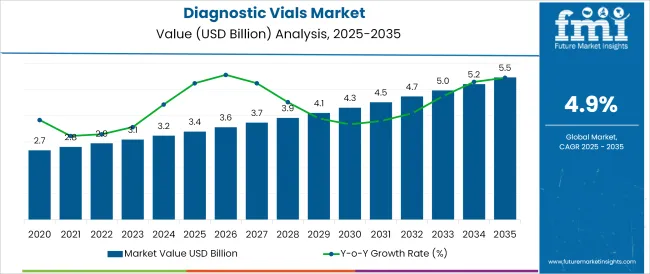
The diagnostic vials market is witnessing steady growth, supported by rising global investments in healthcare infrastructure, expanded access to diagnostic services, and increasing demand for accurate specimen storage in clinical and laboratory settings. The market is being shaped by the growing prevalence of infectious diseases, chronic conditions, and genetic testing, which require safe and sterile sample containment.
Regulatory focus on lab safety and contamination prevention is further encouraging the adoption of high-performance vial materials and formats. Manufacturers are responding with innovations in closure systems, tamper-evident designs, and automation-friendly vial geometries that support high-throughput testing workflows.
Emerging economies are accelerating procurement of diagnostic vials as part of national health programs, while developed markets are investing in automated sample handling systems, driving the need for standardized, high-precision vials. As diagnostic testing becomes more decentralized and portable, vial design is increasingly focused on durability, traceability, and compatibility with rapid testing technologies.
The market is segmented by Material, Product Type, Capacity Range, and End-User and region. By Material, the market is divided into Glass, Tubular, Molded, and Plastic. In terms of Product Type, the market is classified into Round Bottom and Self-Standing. Based on Capacity Range, the market is segmented into 0–2 ml, 3-5 ml, 6–10 ml, 11-20 ml, and Above 20 ml.
By End-User, the market is divided into Hospitals, Medical Institutes, Clinical Labs, Research Institutes, and Pathology & Diagnostic Centres. Regionally, the market is classified into North America, Latin America, Western Europe, Eastern Europe, Balkan & Baltic Countries, Russia & Belarus, Central Asia, East Asia, South Asia & Pacific, and the Middle East & Africa.
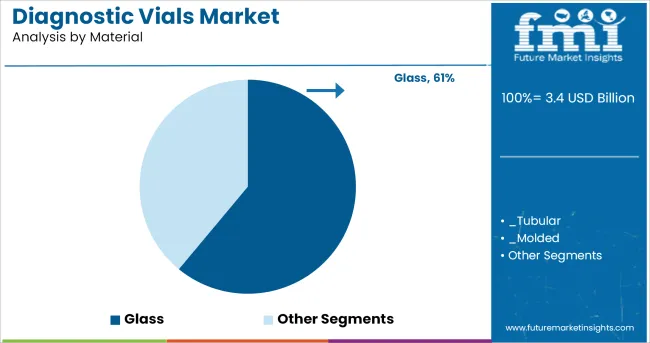
Glass is expected to hold a dominant 61.0% share of the diagnostic vials market by 2025. This leadership is being driven by glass’s superior chemical resistance, thermal stability, and inertness, which are critical for preserving sample integrity in diagnostic applications. The non-reactive nature of borosilicate and other medical-grade glasses ensures compatibility with a wide range of reagents and specimen types, minimizing risk of contamination or test interference.
Glass vials also offer excellent transparency, enabling easy visual inspection of contents, which is essential in both manual and automated laboratory workflows. Despite the growing presence of plastic alternatives, glass continues to be preferred for applications where sterility, barrier performance, and reusability are prioritized.
Regulatory acceptance and a well-established sterilization infrastructure further reinforce its dominance across pathology labs, blood banks, and molecular diagnostics settings.
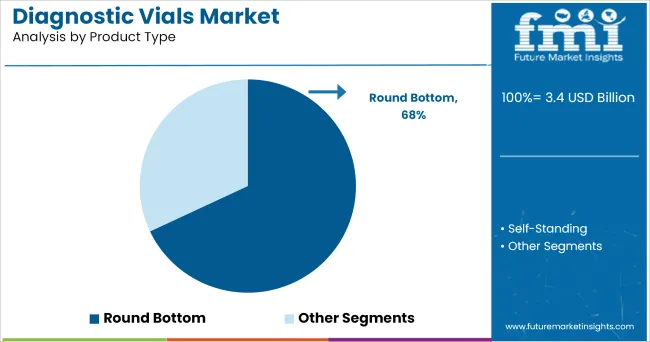
Round bottom vials are projected to contribute 68.0% of revenue in the diagnostic vials market by 2025, making them the leading product type. Their dominance is supported by superior centrifugation compatibility, ease of liquid handling, and consistent sedimentation during diagnostic testing procedures.
The curvature of round bottom vials allows for more efficient fluid collection and minimized dead volume, which enhances sample recovery and test accuracy. Their structural stability during high-speed centrifugation has made them a preferred format in microbiology, hematology, and molecular labs. Additionally, round bottom vials are well-suited for use in automated sample processing systems, where precise alignment and reduced mechanical stress are critical.
As diagnostic workflows continue to evolve toward miniaturization and higher throughput, round bottom formats offer the performance reliability and processing flexibility needed across diverse laboratory environments.
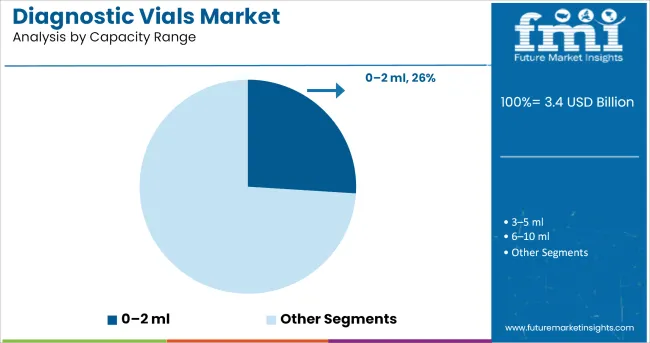
The 0-2 ml capacity range is expected to hold a 26.0% revenue share of the diagnostic vials market in 2025, positioning it as a key volume segment. This range is favored for its alignment with typical sample volumes required in serological, molecular, and immunological testing protocols. The small-volume format minimizes sample waste and supports precise aliquoting, which is essential in both routine diagnostics and research assays.
Vials in this range are compatible with a wide variety of sample collection systems, centrifuge rotors, and auto-analyzers, enhancing workflow efficiency and equipment interoperability. Their compact size also supports cold storage optimization and improved inventory management in clinical labs.
As point-of-care testing and decentralized diagnostics continue to expand, compact, portable vials in the 0–2 ml category are increasingly being selected for field use, home diagnostics, and mobile health units, reinforcing their sustained demand.
The vials are the small container that is used to store the content and is majorly used in pharmaceutical, cosmetic, personal care, and other industries. The diagnostic vials are the vials having a heavy wall which are ideal for freeze-drying and lyophilisation applications.
The diagnostic vials are made from tubular or molded glass or plastic material and are available in different sizes based on the requirement such as 2ml, 3ml, 5ml, 7ml, and others. Moreover, these vials are available with different cap or closure types that are meant to meet the specific storage and shipping requirements such as screw thread, cork or stopper, flip cap, and others.
These diagnostic vials protect the drug or medication content from moisture and other environmental temperature and also, are best suitable for transporting the drug or chemical or medication. The diagnostic vials helps the end-user in consuming the dosage in the right quantity which reduces the chances of human error.
Also, the diagnostic vials help in protecting the medications or drugs from getting contaminated which is the major factor leading the diagnostic vials market. Overall considering the benefits offered by diagnostic vials the demand for the same is anticipated to bolster during the forecasted period along with increasing demand for packaging in the pharmaceutical and healthcare industry as well as increasing development in drugs & medications required for diagnosis.
The main factor driving the demand for diagnostic vials is the protection offered against environmental elements. The plastic diagnostic vials are resistant to breakage as well as are non-vulnerable to corrosion which leads to increasing the shelf life of the drug or medication.
The diagnostic vials made from plastic reduces the risk of delamination. The diagnostic vials helps in marinating the purity of the drug without deteriorating the properties of the drug or medication which bolster the demand for diagnostic vial among the pharmaceutical and healthcare industries.
The rising innovation and development in drugs and medication to cure various health problems push the sales of diagnostic vials. Moreover, the diagnostic vials made from plastic or glass are recyclable which address the sustainable concern.
Increasing demand for unit-dose packaging also augments the sales of diagnostic vials among the end-users. Thus, the various characteristics of diagnostic vials are the key factors that will help in increasing the market for diagnostic vials.
The demand for drugs is increasing in various countries due to the shortage of drugs which leads to the import of drugs from other countries. This will require proper packaging to store and ship the drug or mediation and also the packaging need to be ensured that it protects the drug from various climatic and environmental elements during the transportation.
The need for safety will generate a growth opportunity for the diagnostic vials market. Also, the research in the pharmaceutical and healthcare industries are rising day by day, this also boosts the demand for diagnostic vials.
The diagnostic vials majorly are available in glass material. Also, the demand for glass diagnostic vials is more than the plastic diagnostic vials this limits the market for diagnostic vials as glass diagnostic vials require extra packaging and care while shipping and storing. This increases the cost of transportation.
The production of glass diagnostic vials require more energy and power as glass do not get melted at low temperature which increases the carbon footprint. These factors hinder the market growth of diagnostic vials market.
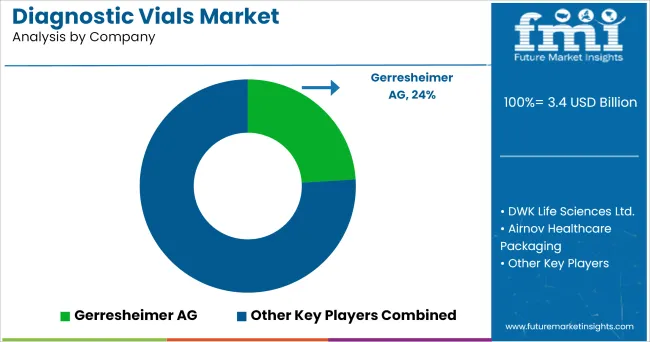
The global key players for diagnostic vials
Some of the APAC players
The key players majorly are trying to expand their capacity by investing and establishing their new plants in the existing as well as in untapped market. Along with this, the players are expanding the capacity and resources by adopting an acquisition strategy.
The key strategies adopted by some of the key manufacturing players
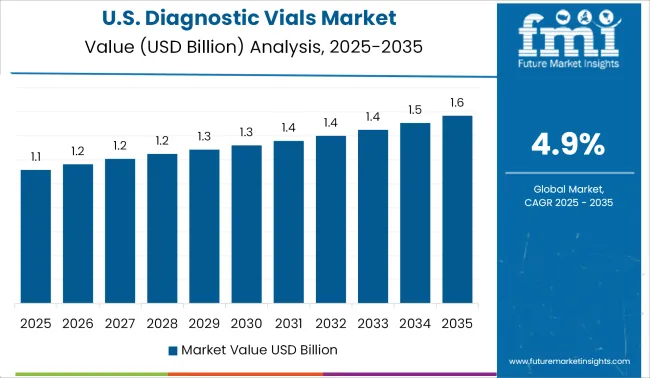
The increasing development in new drugs and medication in the United States to curve various health problems will boost the demand for diagnostic vials. Also, the increasing illness and diseases in the United States will push the sales of diagnostic vials.
According to National Cancer Institute, around 3.2 million new cancer cases were found in the United States in 2024. This rise in the number of cancer cases will raise the demand for diagnostic vials which will be used for storing and transporting the cancer drugs.
The pandemic breakout leads to the development of a new vaccine to curve the virus. The drug manufacturer is developing the vaccines which will require a diagnostic vial to store the drug and to transport it. This will generate a huge demand for diagnostic vials.
The manufacturing of vaccine is increasing to meet the demand due to the large population this lead towards the growth opportunity for the diagnostic vials market. Thus, the increasing demand for the vaccine will supplement the sales of diagnostic vials in India.
The global diagnostic vials market is estimated to be valued at USD 3.4 billion in 2025.
The market size for the diagnostic vials market is projected to reach USD 5.5 billion by 2035.
The diagnostic vials market is expected to grow at a 4.9% CAGR between 2025 and 2035.
The key product types in diagnostic vials market are glass, tubular, molded and plastic.
In terms of product type, round bottom segment to command 68.0% share in the diagnostic vials market in 2025.






Our Research Products

The "Full Research Suite" delivers actionable market intel, deep dives on markets or technologies, so clients act faster, cut risk, and unlock growth.

The Leaderboard benchmarks and ranks top vendors, classifying them as Established Leaders, Leading Challengers, or Disruptors & Challengers.

Locates where complements amplify value and substitutes erode it, forecasting net impact by horizon

We deliver granular, decision-grade intel: market sizing, 5-year forecasts, pricing, adoption, usage, revenue, and operational KPIs—plus competitor tracking, regulation, and value chains—across 60 countries broadly.

Spot the shifts before they hit your P&L. We track inflection points, adoption curves, pricing moves, and ecosystem plays to show where demand is heading, why it is changing, and what to do next across high-growth markets and disruptive tech

Real-time reads of user behavior. We track shifting priorities, perceptions of today’s and next-gen services, and provider experience, then pace how fast tech moves from trial to adoption, blending buyer, consumer, and channel inputs with social signals (#WhySwitch, #UX).

Partner with our analyst team to build a custom report designed around your business priorities. From analysing market trends to assessing competitors or crafting bespoke datasets, we tailor insights to your needs.
Supplier Intelligence
Discovery & Profiling
Capacity & Footprint
Performance & Risk
Compliance & Governance
Commercial Readiness
Who Supplies Whom
Scorecards & Shortlists
Playbooks & Docs
Category Intelligence
Definition & Scope
Demand & Use Cases
Cost Drivers
Market Structure
Supply Chain Map
Trade & Policy
Operating Norms
Deliverables
Buyer Intelligence
Account Basics
Spend & Scope
Procurement Model
Vendor Requirements
Terms & Policies
Entry Strategy
Pain Points & Triggers
Outputs
Pricing Analysis
Benchmarks
Trends
Should-Cost
Indexation
Landed Cost
Commercial Terms
Deliverables
Brand Analysis
Positioning & Value Prop
Share & Presence
Customer Evidence
Go-to-Market
Digital & Reputation
Compliance & Trust
KPIs & Gaps
Outputs
Full Research Suite comprises of:
Market outlook & trends analysis
Interviews & case studies
Strategic recommendations
Vendor profiles & capabilities analysis
5-year forecasts
8 regions and 60+ country-level data splits
Market segment data splits
12 months of continuous data updates
DELIVERED AS:
PDF EXCEL ONLINE
Breaking Down Diagnostic Vials Market Share & Industry Insights
Diagnostic Shipper Market Size and Share Forecast Outlook 2025 to 2035
Diagnostic Imaging Markers Market Size and Share Forecast Outlook 2025 to 2035
Diagnostic Imaging Services Market Size and Share Forecast Outlook 2025 to 2035
Diagnostic Exosome Biomarkers Market Trends – Growth & Forecast 2025 to 2035
Diagnostic X-Ray System Market – Trends & Forecast 2025 to 2035
Diagnostic Tools for EVs Market Growth - Trends & Forecast 2025 to 2035
Diagnostic Stopper Market
DNA Diagnostics Market Size and Share Forecast Outlook 2025 to 2035
HIV Diagnostics Market Size and Share Forecast Outlook 2025 to 2035
Food Diagnostics Services Market Size, Growth, and Forecast for 2025–2035
Rabies Diagnostics Market Size and Share Forecast Outlook 2025 to 2035
Cancer Diagnostics Market Analysis - Size, Share and Forecast 2025 to 2035
Tissue Diagnostics Market Size and Share Forecast Outlook 2025 to 2035
Sepsis Diagnostics Market Growth - Trends & Forecast 2025 to 2035
Dental Diagnostic and Surgical Equipment Market Analysis - Trends & Forecast 2024 to 2034
Allergy Diagnostic Market Forecast and Outlook 2025 to 2035
Poultry Diagnostic Testing Market Size and Share Forecast Outlook 2025 to 2035
Poultry Diagnostics Market - Demand, Growth & Forecast 2025 to 2035
Protein Diagnostics Market Share, Size and Forecast 2025 to 2035

Thank you!
You will receive an email from our Business Development Manager. Please be sure to check your SPAM/JUNK folder too.
Chat With
MaRIA